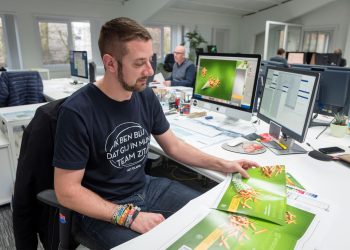In line with its commitment to making the arts more accessible, imaging technology leader Canon is supporting an exhibition in which The White Hands Chorus Nippon (The White Hands Chorus Nippon) will take to the stage for a visual interpretation of “An die Freude” from Beethoven’s 9th Symphony. First performed in Vienna in May 1824, the 9th Symphony returns to the city today, exactly two hundred years later, as part of a diverse and experimental photographic exhibition entitled “An die Freude” (Ode to Joy).
 Bringing together children with and without physical disabilities, the hearing-impaired members of the White Hands Choir Nippon express sound and emotions through sign language, movement and facial expressions.
Bringing together children with and without physical disabilities, the hearing-impaired members of the White Hands Choir Nippon express sound and emotions through sign language, movement and facial expressions.
The exhibition showcases photographs embossed using Canon PRISMAelevate XL printing technology and the Arizona printer series. Canon’s embossed images are produced with the experience of visually impaired individuals in mind.
The embossed print, formed by the overlapping of multiple layers of ink, provides a fully tactile and immersive experience for visitors to visualise the works as a mental representation. The exhibition also features descriptions printed in Braille so that visually impaired visitors can learn the full story behind the music. The exhibition is a continuation of Canon’s efforts to make art more accessible by using technology to pioneer the journey of making and experiencing art for people with disabilities.
 In an experimental photography exhibition in collaboration with the White Hands Choir Nippon, Japanese photographer Mariko Tagashira uses long exposure techniques to find a unique way of capturing children’s gestures as poetic light traces, adding a visible and tactile dimension to the symphony experience. The exhibition is taking place at the WestLicht Museum of Photography in Vienna.
In an experimental photography exhibition in collaboration with the White Hands Choir Nippon, Japanese photographer Mariko Tagashira uses long exposure techniques to find a unique way of capturing children’s gestures as poetic light traces, adding a visible and tactile dimension to the symphony experience. The exhibition is taking place at the WestLicht Museum of Photography in Vienna.
Dirk Brouns, Vice President, Canon Production Printing, Large Format Systems: “The arts should be accessible to everyone. Music and photography are at the heart of this. We are proud to use our imaging technology to enable more people to experience the powerful emotions and stories that White Hands Chorus conveys through Mariko Tagashira’s photography. By creating an alternative sensory experience with our embossed printing technology, we hope to create an exhibition that is truly accessible for people with differences, where everyone can interact and participate.”














